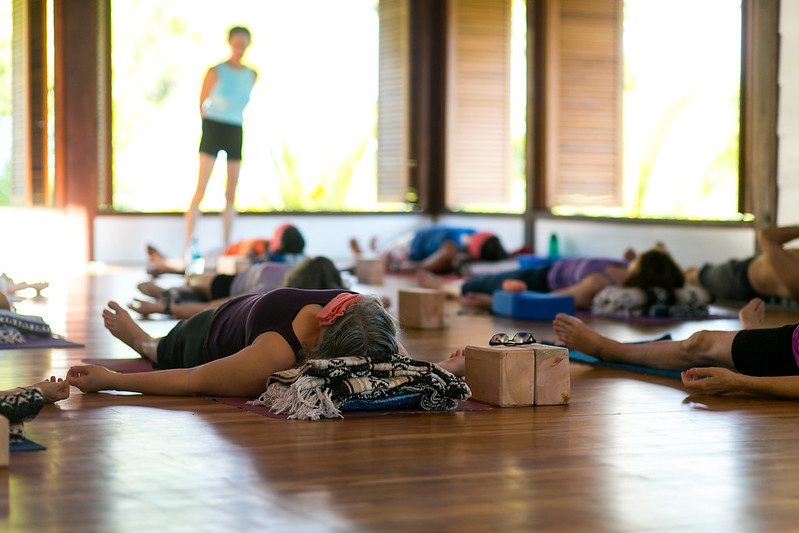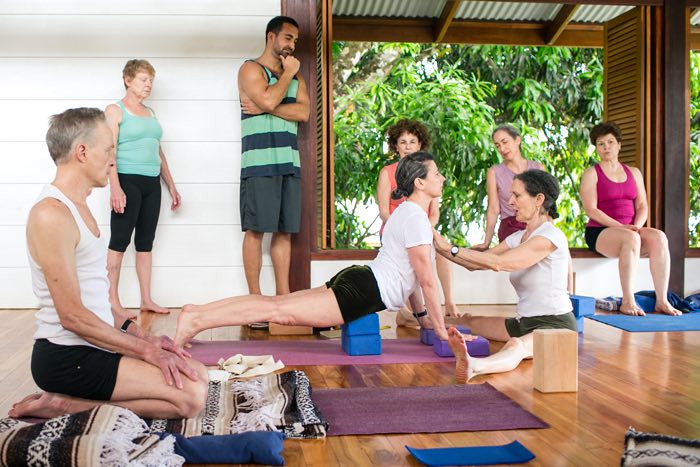You’ve just finished your yoga teacher training and you’re wondering whether you’re ready to start teaching yet. Maybe you’re full of confidence and eager to get going, or perhaps you’re holding back and questioning your ability, or whether you’d prefer to get more experience first. However you’re feeling, I’m here to offer some guidance from the perspective of someone who has been in your position.

Advice For Yoga Teachers Just Starting Out
I’ve been a student of yoga for a little over four years now. Everyone was always telling me to become a yoga teacher. After years of attending many yoga classes with different instructors who each had their own teaching styles, voices, and sequences, I felt I was ready to teach and share my own practice.
I finished my one-month intense training at Blue Osa and joyfully received my yoga certification. The next step was sharing this news with the world. I was full of confidence and keen to embark on my new teaching life. That is, until I went to my mom’s friends house for her birthday dinner. The first thing her friend said to me was “Nikki, these 7 ladies and I are waiting for you to teach a class, does this Saturday sound good?” I couldn’t speak. I stumbled over my words, eventually mumbling a “yes”. I had no idea why I felt so nervous, I thought I was prepared for this moment. The good news is that I did end up teaching a class to them and it went well. I was glad I did it but if it hadn’t been for her surprising me that way, I may not have stepped out of my comfort zone.
My Advice To Recently Qualified Yoga Instructors

Get Out There As Soon As Possible
The longer we wait the less we will have the motivation or confidence to teach. It can be difficult to step out of your comfort zone where you feel safe and secure, but how will we ever know how magnificent something could be unless we try it? View your recent graduation as a great opportunity to challenge yourself and get out there. You could put a class on for your parents, loved ones, or even just one friend. You’ll begin to gain confidence, develop your teaching voice, and explore what makes you happy or nervous. You’ll make mistakes and that’s okay, learn from them. Reflect on the class afterwards and think about anything you weren’t happy with; consider how you would improve next time.
It’s Okay To Bring Your Own Notes
This was actually one of my biggest fears. I was under the impression that when I taught, the sequence had to come naturally without looking at notes. I thought it would be unprofessional otherwise. It turns out this is completely untrue. A friend of mine, who is also a yoga teacher, looked perplexed when I told her this and said “Are you serious? I’ve been teaching for four years and I still take my notes with me!”. I felt so relieved! Sometimes, it’s nice to know you’re not the only one who is unsure. As a result, I’ve been creating fun sequences with reminders in the notes I take to my classes. Sometimes you won’t need your notes but it’s comforting to know that if you lose your flow you’ve got backup.
They’re Not Here For You. They’re Here For Them.
A yoga instructor once told me this. It made so much sense. As yoga instructors, we feel pressure to be perfect, to be able to demonstrate each pose faultlessly, and direct a flawless class. But we’re not perfect. No-one is. The people who attend your class are there for themselves, to take themselves to a better place, and they believe you can help them. They aren’t coming to critique you; they want you to succeed. Be real, and remember why you started teaching – to guide and enhance your student’s practice.
It’s Just Yoga
This was something a teacher of mine often told me before I taught a class. This reminds me to smile and to not take life too seriously. As teachers, we may feel the need to be serious, but this isn’t necessary. You may be responsible for guiding people towards body, mind, and soul healing, but you’re also responsible for radiating positivity, and instilling happiness and relaxation. Don’t forget to smile and have fun.
This Is Your Time To Let Your Creativity Shine
Most of us are told from an early age that our creativity should be expressed in certain ways. As we age, this can suppress our creative energy, and in turn, diminish who we have become in this world. My creative juices are flowing again thanks to yoga. It’s time to turn your favourite music up and flow to it. Come up with sequences that feel natural as you move to the music on your yoga mat. It’s your time to speak the words from your heart and to listen to others’ creativity. It’s an opportunity for you to express yourself, and to be you again.
For me, teaching yoga is more than guiding people to move in certain ways. It’s a time to open up my heart and help others unlock theirs. A time when your problems aren’t important and you guide others to allow their problems to fade away as well. A moment and time to create, grow and to be.
So if you’ve just finished your yoga teacher training or have been waiting for the right moment to start teaching. This is it. Get out there and teach. Believe in yourself.
About The Author
 Born in Colombia, raised in Florida with a mind full of curiosity on spirituality and how to make the world a better place. Nicole has been practicing yoga since she was 16 years old, ever since she’s wanted to expand her yoga practice which has turned into her ultimate passion. She went to Costa Rica where her practice got more deep and now being a certified yoga instructor, still in Costa Rica, as a writer/blogger and finishing her studies on holistic health. Growing up in a household and group of friends full of support and love is what has allowed her to achieve her dreams and to continue to be where she currently is. Expressing her passions with yoga, writing, health and nature through social media wanting to spread her passion through out the world, one picture and one message at a time. (IG: @nicoletovz)(FB: Nicole Tovar)
Born in Colombia, raised in Florida with a mind full of curiosity on spirituality and how to make the world a better place. Nicole has been practicing yoga since she was 16 years old, ever since she’s wanted to expand her yoga practice which has turned into her ultimate passion. She went to Costa Rica where her practice got more deep and now being a certified yoga instructor, still in Costa Rica, as a writer/blogger and finishing her studies on holistic health. Growing up in a household and group of friends full of support and love is what has allowed her to achieve her dreams and to continue to be where she currently is. Expressing her passions with yoga, writing, health and nature through social media wanting to spread her passion through out the world, one picture and one message at a time. (IG: @nicoletovz)(FB: Nicole Tovar)





